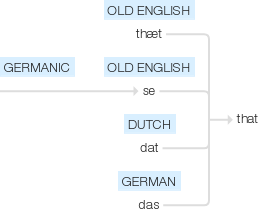That
Old English thæt, nominative and accusative singular neuter of se ‘the’, of Germanic origin; related to Dutch dat and German das .
wiktionary
From Middle English that, from Old English þæt(“the, that”, neuter definite article and relative pronoun), from Proto-Germanic *þat. Cognate to Saterland Frisian dät, West Frisian dat, Dutch dat, Low German dat, German dass and das, Danish det, Swedish det, Icelandic það.
etymonline
that (pron.)
Old English þæt, "that, so that, after that," neuter singular demonstrative pronoun ("A Man's a Man for a' that"), relative pronoun ("O thou that hearest prayer"), and demonstrative adjective ("Look at that caveman go!"), corresponding to masc. se, fem. seo. From Proto-Germanic *that, from PIE *tod-, extended form of demonstrative pronominal base *-to- (see -th (1)).
With the breakdown of the grammatical gender system, it came to be used in Middle English and Modern English for all genders. Germanic cognates include Old Saxon that, Old Frisian thet, Middle Dutch, Dutch dat "that," German der, die, das "the."
Generally more specific or emphatic than the, but in some cases they are interchangeable. From c. 1200 opposed to this as indicating something farther off. In adverbial use ("I'm that old"), in reference to something implied or previously said, c. 1200, an abbreviation of the notion of "to that extent," "to that degree." As a conjunction ("Not that I loved Caesar less, but that I loved Rome more") it was originally the neuter pronoun or adjective that used practically as a definite article qualifying the whole sentence.
Slang that way "in love" first recorded 1929. That-a-way "in that direction" is recorded from 1839. "Take that!" said while delivering a blow, is recorded from early 15c.
